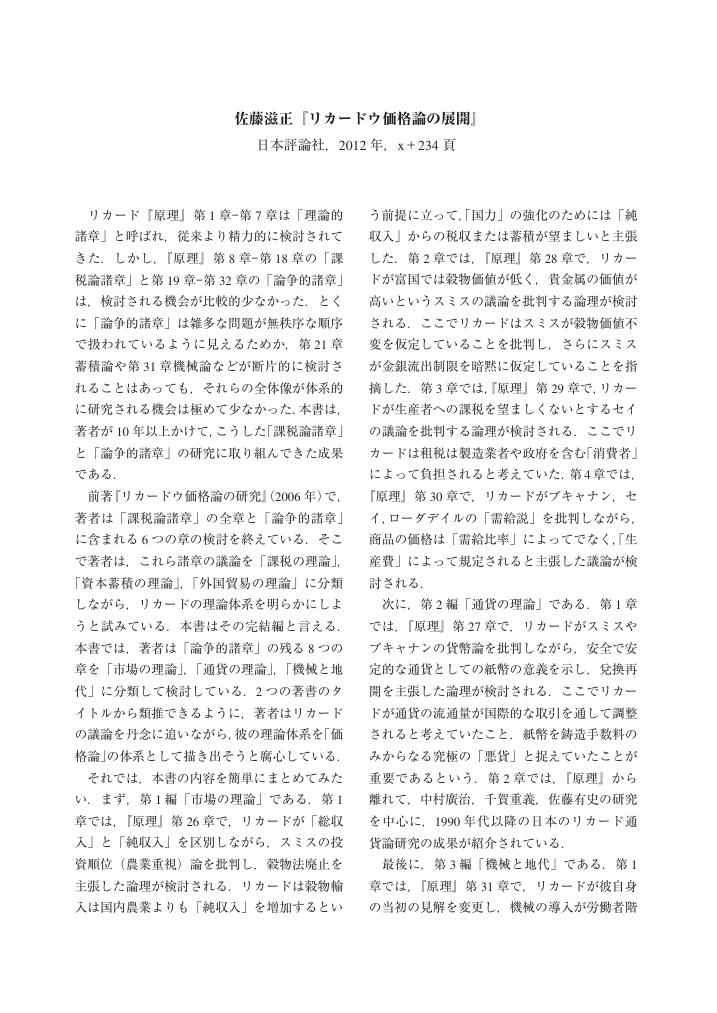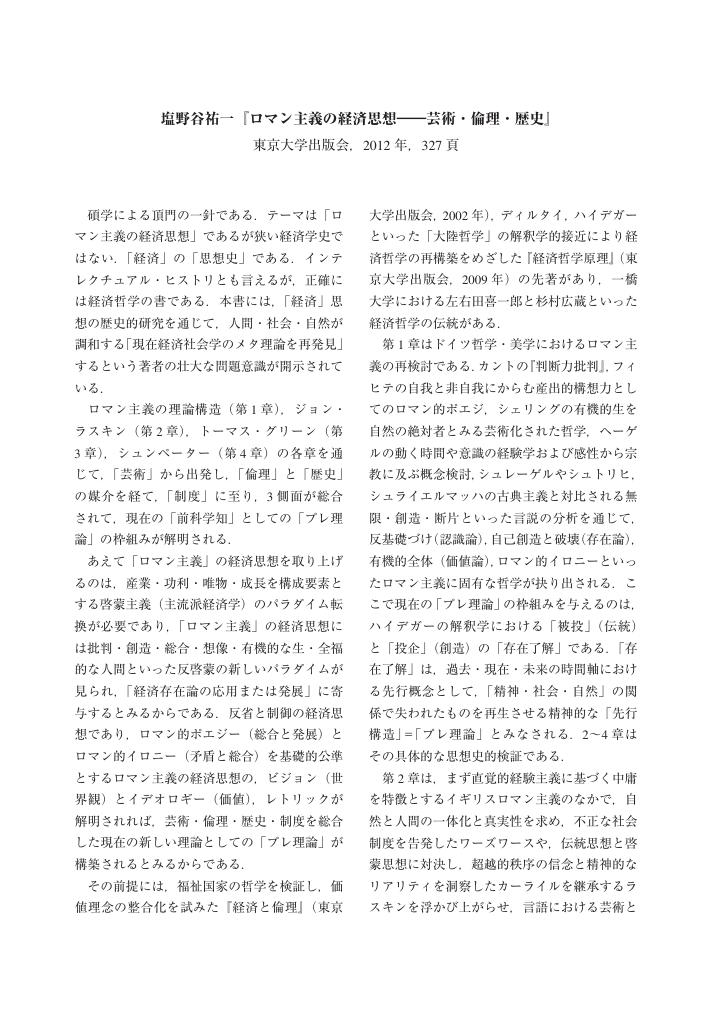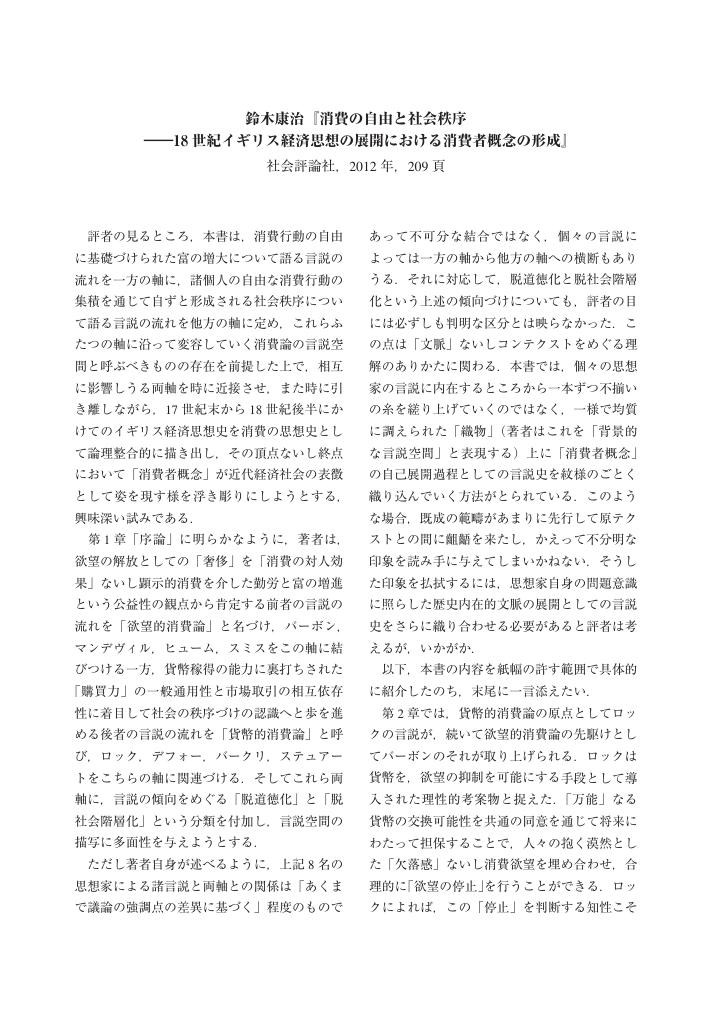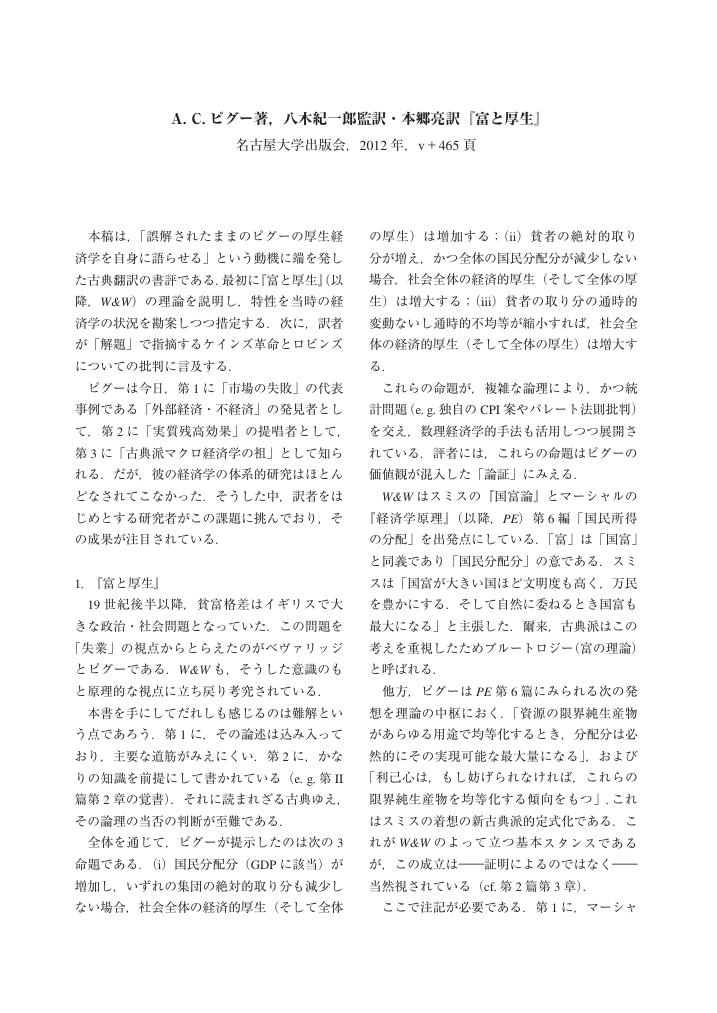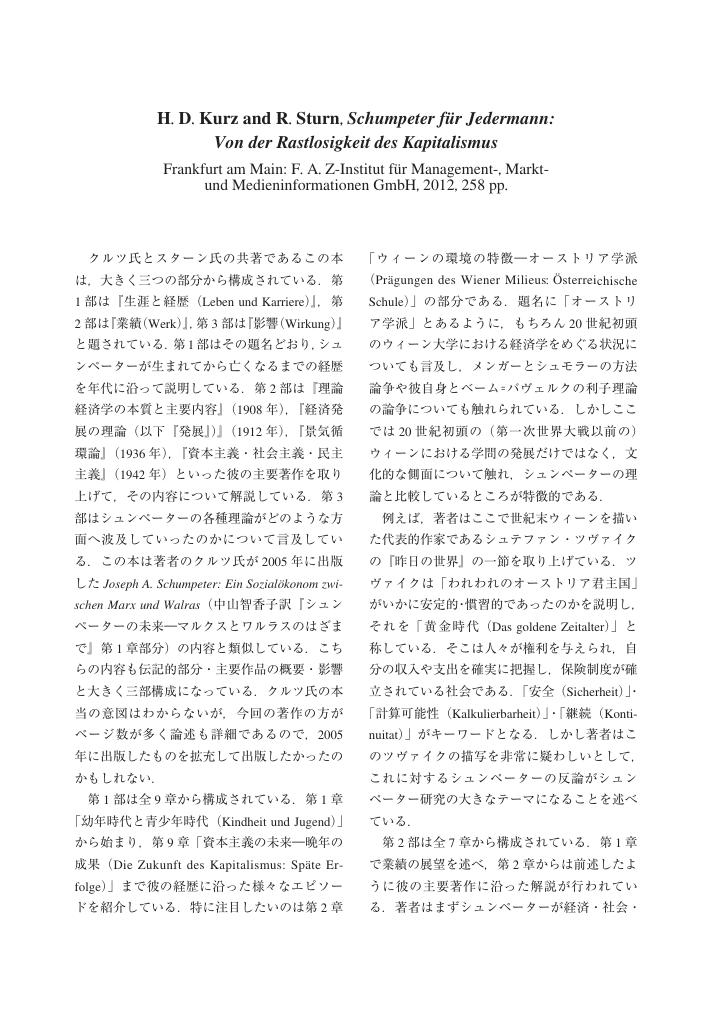1 0 0 0 OA 柴田敬によるベーム-バヴェルク理論の一般化の試み 生産構造の問題を中心として
- 著者
- 西 淳
- 出版者
- 経済学史学会
- 雑誌
- 経済学史研究 (ISSN:18803164)
- 巻号頁・発行日
- vol.56, no.1, pp.48-70, 2014 (Released:2019-08-24)
Abstract: Kei Shibata (1902―1986), a creative theoretical economist, was the first Japanese economist to gain international recognition. One of his most famous works is an attempt to synthesize Walrasian/Casselian General Equilibrium Theory with Marxian Economic Theory. Most of his economic theories were first published in Keizaironso and were later included in his first book, Rironkeizaigaku (meaning theoretical economics) published in 1935 and 1936. After completing this book, Shibata turned to investigating new economic principles be-yond capitalism. Shibataʼs investigation had some byproducts. The most remarkable was an attempt to generalize Böhm-Bawerkʼs concept of the average period of production (APP), which is defined as the length of the roundabout production process, whereby capital goods are first produced and then employed in the production of the final consumer good. This con-cept was criticized because it can only be applied in the case of a single linear stage pattern of production, but not in the case of an autoregressive pattern of input―output structure. Later studies reveal that the concept is destined to fail because as the roundabout period of produc-tion reaches an infinite value, the APP also reaches an infinite value. However, Shibata presented a mathematical way of determining the APP using an autoregressive pattern of the input―output structure. In addition, he concluded that in such cases, the APP has a finite value. His investigation is connected to the concept of the so-called capital intensity in modern economics and the organic composition of capital in Marx-ian economics. Therefore, his findings require further research. Hence, the present study aims to re-examine Shibataʼs contribution to the generalization of Böhm-Bawerkʼs theory of the APP. JEL classification numbers: B 41, B 53, D 24.
1 0 0 0 OA カンティロンとチュルゴ― 古典派的利潤論の形成における企業者概念の意義
- 著者
- 金子 創
- 出版者
- 経済学史学会
- 雑誌
- 経済学史研究 (ISSN:18803164)
- 巻号頁・発行日
- vol.56, no.1, pp.71-88, 2014 (Released:2019-08-24)
Abstract: This study focuses on Richard Cantillonʼs and Anne Robert Jacques Turgotʼs theories of the entrepreneur in order to revisit the conceptual structure of classical economic thought found-ed by Adam Smith. The frameworks of the classical concept of profit, assumed by Cantillon and Turgot are each examined to determine the following four issues: (a) whether a surplus of income over a given subsistence consumption level is distributed to an agent and whether it is saved accordingly; (b) whether and under what kinds of opportunity savings are invest-ed; (c) whether capital accumulation is attained as a consequence of investment; and (d) whether and how a surplus is accrued. Cantillon made four key assumptions in his work. First, he assumed that even if a sur-plus is distributed to an entrepreneur, it is not always saved. Secondly, whenever a surplus is saved, the savings are used only to buy land. Next, because savings are used only for land purchases, capital accumulation is hardly attained. Lastly, the surplus accrued by an entrepre-neur is due to his risk-taking behavior. By contrast, Turgot assumed that an entrepreneur normally saves the surplus that is dis-tributed to him, and that saving is not only used to buy land, but also used for productive in-vestment. He also assumed that because of this productive investment, capital accumulation can be achieved and that an entrepreneur could accrue a surplus from his risk-bearing, provi-sion of advanced labor service, or investment. This research, which takes into consideration each of their assumptions on the long-run state, provides a precise comparison between their frameworks of analysis of the entrepre-neur. Furthermore, this comparison makes it possible to explain that the foundation of the classical framework was related to a change in the assumptions on the behavior of an eco-nomic agent. JEL classification numbers: B 11, B 12.
1 0 0 0 OA OBITUARY Istvan Hont (1947-2013):
- 著者
- 田中 秀夫
- 出版者
- The Japanease Society for the History of Economic Thought
- 雑誌
- 経済学史研究 (ISSN:18803164)
- 巻号頁・発行日
- vol.56, no.1, pp.91-95, 2014 (Released:2019-08-24)
- 著者
- 有江 大介
- 出版者
- 経済学史学会
- 雑誌
- 経済学史研究 (ISSN:18803164)
- 巻号頁・発行日
- vol.56, no.1, pp.117-121, 2014 (Released:2019-08-24)
- 著者
- 高見 典和
- 出版者
- 経済学史学会
- 雑誌
- 経済学史研究 (ISSN:18803164)
- 巻号頁・発行日
- vol.56, no.1, pp.126-128, 2014 (Released:2019-08-24)
- 著者
- 久保 真
- 出版者
- 経済学史学会
- 雑誌
- 経済学史研究 (ISSN:18803164)
- 巻号頁・発行日
- vol.55, no.2, pp.126-127, 2014 (Released:2019-11-28)
1 0 0 0 OA 佐藤滋正『リカードウ価格論の展開』日本評論社,2012年,x+234頁
- 著者
- 福田 Shinji
- 出版者
- 経済学史学会
- 雑誌
- 経済学史研究 (ISSN:18803164)
- 巻号頁・発行日
- vol.55, no.2, pp.128-129, 2014 (Released:2019-11-28)
- 著者
- 姫野 順一
- 出版者
- 経済学史学会
- 雑誌
- 経済学史研究 (ISSN:18803164)
- 巻号頁・発行日
- vol.55, no.2, pp.130-131, 2014 (Released:2019-11-28)
- 著者
- 林 直樹
- 出版者
- 経済学史学会
- 雑誌
- 経済学史研究 (ISSN:18803164)
- 巻号頁・発行日
- vol.55, no.2, pp.132-133, 2014 (Released:2019-11-28)
- 著者
- 平井 俊顕
- 出版者
- 経済学史学会
- 雑誌
- 経済学史研究 (ISSN:18803164)
- 巻号頁・発行日
- vol.55, no.2, pp.134-136, 2014 (Released:2019-11-28)
- 参考文献数
- 2
- 著者
- 山田 鋭夫
- 出版者
- The Japanease Society for the History of Economic Thought
- 雑誌
- 経済学史研究 (ISSN:18803164)
- 巻号頁・発行日
- vol.56, no.1, pp.1-20, 2014 (Released:2019-08-24)
Abstract: Hirata Kiyoaki is a representative historian of economic thought in postwar Japan, a renova-tor of Marxism, and, above all, a theoretician vis-à-vis civil society. The thinkers he principal-ly examined were Quesnay, Marx, and Gramsci. Through the study of these three theoreti-cians, his thinking on civil society germinated, fully developed, and finally experienced a sort of change. In this essay, I will follow the development of and changes in his theory, as well as his original and fundamental analytical approach with regard to economic society; in so do-ing, I wish to elucidate the contemporary significance and limits of his civil society theory. The original nature of Hirataʼs theory resides in the fact that he analyzes economic soci-ety from a “process and structure” approach. In early Hirataʼs study of Quesnay, this was ex-pressed in terms of the methodological pivot of the “circuit of productive capital and structure of reproduction,” leading to a solution of the so-called enigma of the Tableau économique. In middle-aged Hirataʼs study of Marx, he began to place the greatest analytical emphasis on the “capital circuit” or “process,” rather than on “structure.” This resulted in an exploration of problems pertaining to property: the inversion of the law of appropriation and the re-estab-lishment of individual property. Here we see the full development of his theory of civil socie-ty, which addressed many pressing questions posed with respect to actual issues of the times: civil society and community, civil society and capitalism, and civil society and socialism. Later-years Hirata adopted the Gramscian theory of hegemony, thus shifting his attention to a civil society theory that differed from that of his younger years. By stressing the Gramscian genealogy of the word régulation of the French régulation school, it seems that he had found in this concept his own approach to “process.” In other words, his initial approach to “structure,” another one in his younger days, may have gradually faded away, or his death may have hindered him from the active development of this approach. However, as a cost of it having not been developed, his thoughts on the “re-establishment of individual property”-which he substantiated as part of his approach to “process”-have become something that does retain universal value even today. JEL classification numbers: B 14, B 31, B 52.
1 0 0 0 OA D. ヒュームの租税・公債論と社会秩序論の展開
- 著者
- 川脇 慎也
- 出版者
- 経済学史学会
- 雑誌
- 経済学史研究 (ISSN:18803164)
- 巻号頁・発行日
- vol.55, no.2, pp.92-105, 2014 (Released:2019-08-23)
This paper explores why Hume wrote essays on tax and public credit in his Political Discourses, in light of the conclusion of his A Treatise of Human Nature. In the Treatise, Hume reached the conclusion that a stable government is need-ed to maintain the stability of the society, which is likely to be diminished by the various kinds of self-interest of its members. According to his es-say on public credit in the Discourses, the Brit-ish government suffered its public finance crisis due to struggles among political parties and the prevailing policies governing the international balance of power. He worried that the increasing lack of faith in the British governmentʼs ability to manage public finance would bring about its collapse. Furthermore, he asserted that should the British government fall, civil society would be unable to subsist. Therefore, he suggested ways for the British government to handle and overcome its public finance crisis in his essay on tax. Humeʼs prescription was as follows: The consumption of luxury should be increased, be-cause individuals always seek luxurious goods to gratify their own desires. Moreover, he advo-cated encouraging refinement in the arts and manners, because he perceived that this would decrease the price of luxurious goods and in-crease their consumption and the tax revenue. Thus, Hume considered excise on luxury goods as the best measure for overcoming the crisis. The reason for Hume writing these essays on tax and public debt lay in his belief that the col-lapse of the British government needed to be avoided at all costs, in the interests of maintain-ing social order. JEL classification number: B 12.
- 著者
- 篠原 久
- 出版者
- The Japanease Society for the History of Economic Thought
- 雑誌
- 経済学史研究 (ISSN:18803164)
- 巻号頁・発行日
- vol.55, no.2, pp.106-108, 2014 (Released:2019-08-23)
1 0 0 0 OA 欧米での科学社会論を用いた経済学史研究
- 著者
- 高見 典和
- 出版者
- 経済学史学会
- 雑誌
- 経済学史研究 (ISSN:18803164)
- 巻号頁・発行日
- vol.55, no.2, pp.109-115, 2014 (Released:2019-08-23)
- 著者
- 武藤 功
- 出版者
- 経済学史学会
- 雑誌
- 経済学史研究 (ISSN:18803164)
- 巻号頁・発行日
- vol.55, no.2, pp.116-117, 2014 (Released:2019-11-28)
- 著者
- 浅田 統一郎
- 出版者
- 経済学史学会
- 雑誌
- 経済学史研究 (ISSN:18803164)
- 巻号頁・発行日
- vol.55, no.2, pp.118-119, 2014 (Released:2019-11-28)
- 著者
- 松山 直樹
- 出版者
- 経済学史学会
- 雑誌
- 経済学史研究 (ISSN:18803164)
- 巻号頁・発行日
- vol.55, no.2, pp.120-121, 2014 (Released:2019-11-28)
- 著者
- 本吉 祥子
- 出版者
- 経済学史学会
- 雑誌
- 経済学史研究 (ISSN:18803164)
- 巻号頁・発行日
- vol.55, no.2, pp.122-123, 2014 (Released:2019-11-28)
- 被引用文献数
- 1






